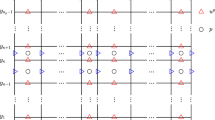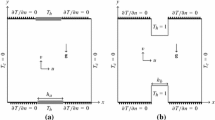Abstract
In this paper, three-dimensional numerical algorithm is constructed to simulate the behavior of the Brinkman-Forchheimer flow and thermal fields. Numerical results of velocity, pressure and temperature are obtained by applying the efficient modified two-grid marker and cell (MAC) algorithm on staggered grids with the second-order backward difference formula (BDF2) time approximation. The modified-upwind idea is introduced to convective heat transfer equations for improving accuracy without any numerical oscillation. The second-order convergence rate can be achieved for pressure, velocity and temperature of considered three-dimensional model. Some numerical experiments are presented to illustrate the efficiency of algorithm. The numerical example with analytical solution is used to validate the effectiveness and accuracy of the algorithm by comparing with the results of traditional MAC algorithm. A time-dependent test is proposed to show a detailed sensitivity analysis to indicate the influence of parameters including the \(\varepsilon \), Forchheimer number, Brinkman number and thermal diffusivity on the physical properties of Brinkman-Forchheimer flow and heat transfer in porous media.
Similar content being viewed by others
References
Straughan, B.: Stability and wave motion in porous media. in: Appl. Math. Sci. 91(2004), Springer
Zhou, Z., Liang, D.: The mass-preserving and modified-upwind splitting DDM scheme for time-dependent convection-diffusion equations. J. Comput. Appl. Math. 317, 247–273 (2017)
Fan, G., Liu, W., Song, Y.: A modified-upwind with block-centred finite difference scheme based on the two-grid algorithm for convection-diffusion-reaction equations. Int. J. Comput. Math. 100(5), 1009–1030 (2023)
Yang, K., Li, X., Liu, K., Wang, J.: Coupling effect of heat transfer in plate heat exchanger filled with porous media. Int. J. Heat Mass. Tran. 182(2022). https://doi.org/10.1016/j.ijheatmasstransfer.2021.121966
Leroy, V., Goyeau, B., Taline, J.: Coupled upscaling approaches for conduction, convection, and radiation in porous media: theoretical developments. Transp. Porous Media. 98(2), 323–347 (2013)
Alzahrani, A.K.: Importance of Darcy-Forchheimer porous medium in 3D convection flow of carbon nanotubes. Phys. Lett. A. 382(40), 2983–2943 (2018)
Ambartsumyan, I., Khattatov, E., Nguyen, T., Yotov, I.: Flow and transport in fractured poroelastic media. GEM Int. J. Geomath. 10(1), 34 (2019)
Lam, PAK., Prakash, KA.: A numerical study on natural convection and entropy generation in a porous enclosure with heat sources. Int. J. Heat Mass Transf. 69, 390-407 (2014)
Rashidi, S., Dehghan, M., Ellahi, R., Riaz, M., Jamal-Abad, M.T.: Study of stream wise transverse magnetic fluid flow with heat transfer around an obstacle embedded in a porous medium. J. Magn. Magn. Mater. 378, 128–137 (2015)
Garcia-Chan, N., Licea-Salazar, J.A., Gutierrez-lbarra, L.G.: Urban heat island dynamics in an Urban-Rural domain with variable porosity: numerical methodology and simulation. Mathematics. 11(5) (2021)
Lebedev, V.L.: Difference analogues of orthogonal decompositions, fundamental differential operators and certainboundary-value problems of mathematical physics. Z. Vycisl. Mat. i Mat. Fiz. 4, 449–465 (1964)
Daly, B.J., Harlow, F.H., Shannon, J.P., Welch, J.E.: The MAC method. Tech. Rep. No. LA-3425, Los AlamosScientific Laboratory, (1965)
Nicolaides, R.A.: Analysis and convergence of the MAC scheme I The linear problem. SIAM J. Numer. Anal. 29, 1579–1591 (1992)
Han, H., Wu, X.: A new mixed finite element formulation and the MAC method for the Stokes equations. SIAM J. Numer. Anal. 35, 650–571 (1998)
Girault, V., Lopez, H.: Finite-element error estimates for the MAC scheme. IMA J. Numer. Anal. 16, 347–379 (1996)
Li, J., Sun, S.: The superconvergence phenomenon and proof of the MAC scheme for the stokes equations on non-uniform rectangular meshes. J. Sci. Comput. 65(1), 341–362 (2015)
Rui, H., Li, X.: Stability and superconvergence of MAC scheme for stokes equations on nonuniform grids. SIAM J. Numer. Anal. 55(3), 1135–1158 (2017)
Li, X., Rui, H.: Superconvergence of MAC scheme for a coupled free flow-porous media system with heat transport on non-uniform grids. J. Sci. Comput. 90(3) (2022)
Bijl, H., Carpenter, M.H., Vatsa, V.N., Kennedy, C.A.: Implicit time integration schemes for the unsteady compressible Navier-CStokes equations: laminar flow. J. Comput. Phys. 179(1), 313–329 (2002)
Carpenter, M.H., Viken, S.A., Nielsen, E.J.: The efficiency of high order temporal schemes, In: AIAA Paper. 86, (2003)
Wang, L., Mavriplis, D.J.: Implicit solution of the unsteady euler equations for high-order accurate discontinuous Galerkin discretizations. J. Comput. Phys. 225(2), 1994–2015 (2007)
Hairer, E., Wanner, G.: Solving differential equations II: stiff and differential-algebraic problems, in: Spring Series in Computational Mathematics. 14, second ed., Springer, Berlin, (1996)
Chen, H., Xu, D., Cao, J., Zhou, J.: A formally second order BDF ADI difference scheme for the three-dimensional time-fractional heat equation. Int. J. Comput. Math. 97(5), 1100–1117 (2020)
Chen, W., Wang, X., Yang, Y., Zhang, Z.: A second order BDF numerical scheme with variable steps for the Cahn-Hilliard equation. SIAM J. Numer. Anal. 57(1), 495–525 (2019)
Ikoen, S., Toivanen, J.: Operator splitting methods for pricing american options under stochastic volatility. Numer. Math. 113, 299–324 (2009)
Xu, J.: A novel two-grid method for semilinear elliptic equations. SIAM J. Sci. Comput. 15(1), 231–237 (1994)
Xu, J.: Two-grid discretization techniques for linear and nonlinear PDEs. SIAM J. Numer. Anal. 33(5), 1759–1777 (1996)
Rui, H., Liu, W.: A two-grid block-centered finite difference method for Darcy-Forchheimer flow in porous media. SIAM J. Numer. Anal. 53(4), 1941–1962 (2015)
Chen, C., Liu, W.: Two-grid volume element methods for semilinear parabolic problems. Appl. Numer. Math. 60(1–2), 10–18 (2010)
Chen, C., Li, K., Chen, Y., Huang, Y.: Two-grid finite element methods combined with Crank-Nicolson scheme for nonlinear Sobolev equations. Adv. Comput. Math. 45(2), 611–630 (2019)
Chen, L., Zheng, B., Lin, G., Voulgarakis, N.: A two-level stochastic collacation method for semilinear elliptic equations with random coefficients. J. Comput. Appl. Math. 315, 195–207 (2017)
Chen, L., Chen, Y.: A novel discretization method for Semilinear Reaction-Diffusion Equation. Adv. Appl. Math. Mech. 10(2), 409–423 (2018)
Raghavan, A., Wei, H., Palmer, T., Debroy, T.: Heat transfer and fluid flow in additive manufacturing. J. Laser Appl. 25, 052006 (2013)
Mahdi, J.M., Lohrasbi, S., Nsofor, E.C.: Hybrid heat transfer enhancement for latent-heat thermal energy storge systems: a review. Int. J. Heat Mass Transf. 137, 630–649 (2019)
Weiser, A., Wheeler, M.F.: On convergence of block-centered finite differences for elliptic problems. SIAM J. Numer. Anal. 25, 351–375 (1988)
Rui, H., Zhao, D., Pan, H.: A block-centered finite difference method for Darcy-Forchheimer model with variable Forchheimer number. Numer. Meth. Part. Diff. Equ. 31, 1603–1622 (2015)
Rui, H., Pan, H.: A block-centered finite difference method for Darcy-Forchheimer model. SIAM J. Numer. Anal. 50, 2612–2631 (2012)
Cen, D., Wang, Z.: Time two-grid technique combined with temporal second order difference method for two-dimensional semilinear fractional sub-diffusion equations. Appl. Math. Lett. 129 (2022), https://doi.org/10.1016/j.aml.2022.107919
Darcy, H.P.: Les Fontaines publiques de la ville de Dijon. Exposition et application des principes á suivre et des formules á employer dans les questions de distribution deau, etc. V. Dalamont. (1856)
Ebrahimnia-Bajestan, E., Moghadam, M.C., Niazmand, H., Daungthongsuk, W., Wongwises, S.: Experimental and numerical investigation of nanofluids heat transfer characteristics for application in solar heat exchangers. Int. J. Heat Mass Transf. 92, 1041–1052 (2015)
Nissen, A., Keilegavlen, E., Sandve, T.H., Berre, I., Nordbotten, J.M.: Heterogeneity preserving upscaling for heat transport in fractured geothermal reservoirs. Comput. Geosci. 22(2), 451–467 (2018)
Sanchez, M.T., Perez, M.A., Garcia-Aznar, J.M.: The role of fluid flow on bone mechanobiology: mathematical modeling and simulation. Comput. Geosci. 25(2), 823–830 (2020)
Bao, K., Lavrov, A., Nilsen, H.M.: Numerical modeling of non-Newtonian fluid flow in fractures and porous media. Comput. Geosci. 21(5–6), 1313–1324 (2017)
Tasnim, S.H., Mahmud, S., Fraser, R.A., Pop, I.: Brinkman-Forchheimer modeling for porous media thermoacoustic system. Int. J. Heat Mass Transf. 54(17–18), 3811–3821 (2011)
Sun, S., Firoozababi, A., Kou, J.S.: Numerical modeling of two-phase binary fluid mixing using mixed finite elements. Comput. Geosci. 16(4), 1101–1124 (2012)
Lee, S., Wheeler, M.F., Wick, T.: Pressure and fluid-driven fracture propagation in porous media using an adaptive finite element phase field model. Comput. Meth. Appl. Mech. Eng. 305, 111–132 (2016)
Boon, W.M., Nordbotten, J.M., Yotov, I.: Roubust discretization of flow in fractured porous media. SIAM J. Numer. Anal. 56(4), 2203–2233 (2018)
Wang, Y., Sun, S., Yu, B.: Acceleration of gas flow simulations in Dual-Continuum porous media based on the Mass-Conservation POD method. Energies. 10(9) (2017)
Liu, C., Frank, F., Thiele, C., Alpak, F.O., Berg, S., Chapman, W., Riviere, B.: An efficient numerical algorithm for solving viscosity contrast Cahn-Hilliard-Navier-Stokes system in porous media. J. Comput. Phys. 400,(2019)
Acknowledgements
This work is supported by China Postdoctoral Science Foundation No. 2021T140576 and No. 2020M672505, Shandong Provincial Natural Science Foundation No. ZR2023MA052.
Author information
Authors and Affiliations
Corresponding authors
Ethics declarations
Competing interests
The authors have no competing interests to declare that are relevant to the content of this article.
Additional information
Publisher's Note
Springer Nature remains neutral with regard to jurisdictional claims in published maps and institutional affiliations.
Appendix: error proof
Appendix: error proof
1.1 Error proof for the Lemma 11
Here we show the error proof for the Lemma 11.
Proof
Set
We define
From Lemma 4 and 5 and Eq. 2.26, we obtain that for \(i=1,...,N_{x}-1\), \(j=0,...,N_{y}-1\), \(l=0,...,N_{z}-1\),
where,
Noting Lemma 2 and multiplying Eq. 6.1 by \(v_{i.j+1/2,l+1/2}^{x}H_{i}^{x}H_{j+1/2}^{y}H_{l+1/2}^{z}\) with discrete function \(\textbf{v}=(v^{x},v^{y},v^{z})\in \textbf{V}_{H}\) making summation on \(i=1,\cdots ,N_{x}-1\), \(j=0,...,N_{y}-1\), \(l=0,...,N_{z}-1\), and similarly in y and z direction, we have
Choosing \(\textbf{v}=E_{\tilde{\textbf{u}}}^{K+1}\) in Eq. 6.4, and then since \(F([\textbf{SU}^{K+1}]\textbf{U}^{K+1}-[\textbf{S}\tilde{\textbf{u}}^{K+1}]\tilde{\textbf{u}}^{K+1},E_{\tilde{\textbf{u}}}^{K+1})\ge 0\) and noting Lemma 10, we have
and
Therefore, we have
Choosing \({\textbf {v}}= D_{t}{E_{\tilde{{\textbf {u}}}}^{K+1}}\) in Eq. 6.4, and deducing in a similar way then we can get
and
In what follows, we establish the error analysis for the temperature. Recalling Eq. 2.29, we have for \(i=0,...,N_{x}-1\), \(j=0,...,N_{y}-1\) and \(l=0,...,N_{z}-1\),
where
Recalling Eq. 2.28 we can get
where \(\nabla _{h}=(D_{x},D_{y},D_{z})\), and
Combining Lemma 2, Eqs. 6.10 and 6.13, we get
We are now in position to prove our main results. Combining Eqs. 6.7, 6.9 and 6.15 we obtain
According to the definition of \({\delta _{p}^{\tilde{{\textbf {u}}}},{K+1}}\) and \(\delta _{T}^{K+1}\), we can complete the proof.
1.2 Error proof for the Lemma 16
Here we show the error proof for the lemma 16.
Proof
Set
Similar to the proof of Lemma 11, the definition of \(\delta _{p}^{\tilde{\textbf{u}}}\), Lemmas 4, 5 and Eq. 2.30, we can get that for \(m=1,\cdots ,n_{x}-1\), \(n=0,\cdots ,n_{y}-1\), \(b=0,\cdots ,n_{z}-1\),
Combining the Taylor expansion, the definition of \(Q_{\varepsilon }^{x}({{\textbf {U}}}_{h})_{m,n+1/2,b+1/2}^{k+1}\) and Eq. 6.17, we can obtain
By Eq. 6.18, Lemmas 10, 14 and Cauchy-Schwartz inequality, we obtain
Similarly we can get
And the rest proof process is similar to the Lemma 11, we shall omit it for simplicity. Finally, we can get,
Rights and permissions
Springer Nature or its licensor (e.g. a society or other partner) holds exclusive rights to this article under a publishing agreement with the author(s) or other rightsholder(s); author self-archiving of the accepted manuscript version of this article is solely governed by the terms of such publishing agreement and applicable law.
About this article
Cite this article
Liu, W., Song, Y., Chen, Y. et al. Numerical simulation on staggered grids of three-dimensional brinkman-forchheimer flow and heat transfer in porous media. Comput Geosci (2024). https://doi.org/10.1007/s10596-023-10266-7
Received:
Accepted:
Published:
DOI: https://doi.org/10.1007/s10596-023-10266-7
Keywords
- Three-dimensional numerical simulation
- Brinkman-Forchheimer flow
- Heat transfer
- Marker and cell algorithm
- Staggered grids




